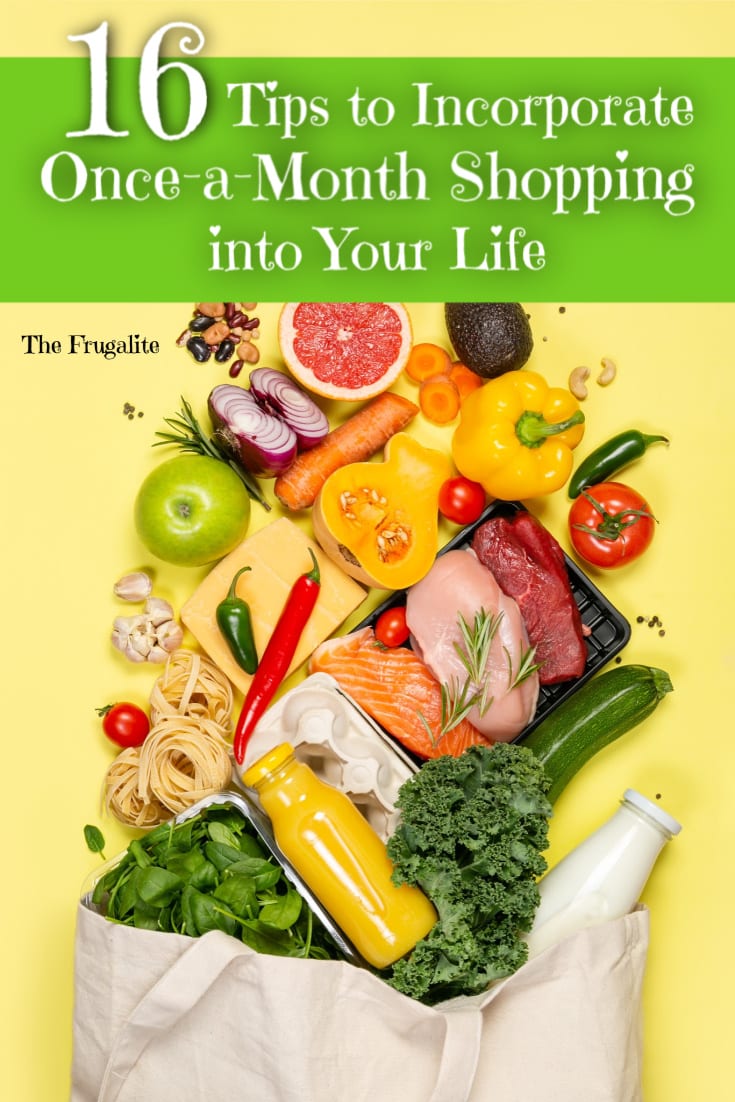(Psst: The FTC wants me to remind you that this website contains affiliate links. That means if you make a purchase from a link you click on, I might receive a small commission. This does not increase the price you’ll pay for that item nor does it decrease the awesomeness of the item. ~ Daisy)
Okay…so you’re going to dive into Once-a-Month Shopping, but how do you get started?
I’ve lived in some pretty remote areas where running to the store for just a few things – or even once a week – is not really feasible, so I switched to once a month shopping. The following tips are things I learned in the process. In fact, I saved so much money that I continued shopping this way although I supplement with the farmer’s market or my own garden in good weather.
16 things you need to know about once-a-month shopping
Prepare to save a lot of money! Here are some tips to help you get started. Soon you’ll adapt this way of shopping and make it your own.
- Make a menu plan before you go shopping. Even if you veer from the plan, you’ll still have the ingredients on hand to make full meals. I like to plan out 5 dinners per week and leave the other two (plus lunches) open for leftovers. I can cheerfully eat the same thing for breakfast every day, so that’s very easy to calculate.
- When planning, think about what the ingredients are. Plan to have meals with the freshest ingredients first, then the longer-lasting ingredients, then the shelf-stable or freezer ingredients. Examples below.
- Week 1: Foods that are quick to spoil, like salad greens, asparagus, green beans, broccoli, peppers, fresh berries, bananas, zucchini
- Week 2: Hardier produce like carrots, brussels sprouts, pears, oranges, cabbage, leeks
- Weeks 3 & 4: Now’s the time to switch to frozen fruits and vegetables. (You can also use canned or dehydrated. We absolutely love applesauce, for example, and that works well as our week-4 fruit.) Some things that will last well into the fourth week if properly stored are carrots, potatoes, winter squash, turnips, rutabagas, apples, and sweet potatoes.
- Head to the store. With these guidelines in mind, when you go to the grocery store, pick up enough fresh fruits and veggies to get you through a couple of weeks. Then, be sure that you have enough frozen, canned, or dehydrated products to see you through the last two weeks.
- Pick up enough dairy products for the month. If you have the space, you can easily freeze milk to be used later. The higher the percentage of milk fat, the more you may need to shake it up after it thaws. Cheese freezes well, but you should expect it to crumble instead of slicing when it thaws.
- Sour cream tips. It can be frozen if you are planning to use it in baking or cooking but isn’t very good if you intend to use it as a condiment. Instead of sour cream, try homemade plain yogurt. It tastes very similar and is quite simple to make yourself. (You can learn how in the next article.)
- Eggs will be fine for an entire month in the refrigerator. Think about how many eggs your family eats and stock up. If you don’t have enough refrigerator space, then you can freeze one egg per square in an ice cube tray, then move them into a freezer big when they’ve frozen solid.
- Keep your storage spaces in mind when you’re on your shopping trip. Both of our freezers have a bit of space after last month, and there’s some room in the fridge, but you want to be careful not to get more than you can cram in. Opt for shelf-stable options if you don’t have enough fridge and freezer space.
- Think about fresh greens. Start working on those solutions for fresh greens when you can’t go to the store: sprouting, a windowsill garden, a greenhouse, a hoop house.
- Think ahead about your month. Do you have any special occasions to prepare for? Any birthdays or school parties or potlucks or guests? You’ll want to have the right supplies on hand for any unusual events.
- It’s not just about food. Next, move on to things like toilet paper, laundry soap, dishwasher detergent, and bleach for the month. Keep supplies on hand to make your own if you run out. (Better yet, start off with the supplies and make your own to save money!)
- Remember health and beauty aids. Don’t forget about personal hygiene items like toothpaste, toothbrushes, shampoo, deodorant, and female supplies. Better to get a bit too much than not enough!
- Get supplies for furry, finned, and feathered friends. How much do your pets and livestock need to get through the month in good health? Pick that up at the store and stash it away.
- Grab OTC meds. Do you have things like over-the-counter medications and special foods in case someone is under the weather? It’s best to stock up on these things ahead of time instead of waiting until you need them. Trust me, as a single mom, when I’m the one who is sick, it’s horrible to have to go to the store to pick up medication or ginger ale.
Are you ready to get started?
You’ll probably have some hiccups, but this will save you all sorts of money in the long run. Ask any questions you might have in the comments, and if you are a once-a-month shopper already, share your tips for those getting started. ?












6 thoughts on “16 Tips to Successfully Incorporate Once-a-Month Shopping into Your Life”
I found a recipe not long ago for sour cream from non-refrigerated ingredients: https://theboatgalley.com/wprm_print/recipe/40129. That same site also has a recipe to make sour cream from powdered milk. I haven’t tried either of these yet, but the first one especially seems to get pretty good reviews, so I did buy some media creama for my pantry. 🙂
Thanks Wendy, I have only two recipes where I use sour cream. And often forget to get it when I’m at the store. I’ll definitely check these recipes out !
Good tips. I aim at three weeks between trips to town. Tomatoes and sprouts work well for us. I gave up on salads. Prepared salads were getting forgotten. Canned picante sauce has replaced pico de galIo. Minor change. I pressure cook beans. We love chili. I keep powdered milk on hand. Chedar cheese that crumbles after freezing is fine. Cream sauce made with powdered milk is great as a gravy or creamsauce base for cooking. Serve it over potatoes, spaghetti, biscuits, or stir in crumbled cheese to make a rich cheese sauce to serve over veggies or macaroni. Husband loves pot pie. Great way to use up leftovers. Just showing how versatile some things can be. I buy both corn and flour tortillias. Flour tortillas and canned pie filling make fast fried pies. Moisten the outter edge. Place filling in the middle then fold in half and seal. Fry to golden brown and drain. Sprinkle with sugar and cinnamon if desired. I don’t let much get away. If by chance it happens, it goes in the compost.
Being married to retired military, allotments come in at the very beginning of the month. We normally shop at the Commissary 1x a month for the majority of our meats, canned goods, staples & dry cat food… usually second week of the month after the store has restocked from military payday. Paper products, coffee & cleaning supplies are bought in bulk from Sam’s Club. Once a month I get livestock feed & dog food from Tractor Supply.
I am still working a couple days each week, so I do shop for dairy, fresh fruits & veggies every 2 weeks. All my grocery & feed store trips are done on the way to work or on the way home.
My best tip….Always check out the clearance/ damaged goods location in the stores. In 3 years, I have paid full price for my GSD’s top quality dog food just 3 or 4 times, as there frequently were bags of her brand that had been ripped during shipment & were marked way down. I have gotten alfalfa cubes/ pellets, chicken feeds, pelleted dewormers that were marked down due to damaged bags/ containers. In grocery stores, meat & cheese due to expire , as well as damaged boxed goods like pasta, cereals are often marked down, as are canned items close to their expiration date. It’s worth checking out the clearance sections….
This past year we really worked to build up our supply of canned goods & pantry basics & increase our livestock/ pet supplies from a couple of months’ worth to a minimum of 4-6 months worth of these. Our goal is to maintain that basic level of preparations.
Here’s a quick recipe that can be made to only use canned goods – I call it Pantry Borscht. 2 cans of beets (not the pickled kind), 1 can of diced tomatoes (really any kind of tomato), some carrots (use canned or cooked from fresh) and blend that till smooth. Add dill and some chicken bullion and heat on the stove till warm, then add your protein. Can be chunks of chicken, either regular kind or out of a can. Or could be mushrooms. Or something else. This is a great soup to hide spare vegetables in.
I make plain yogurt from reconstituted powdered milk. If I need sour cream I drain yogurt in a fine strainer till it’s very thick. I often add canned diced fruits to yogurt for an easy desert. If i need buttermilk i sour some reconstituted powdered milk with a little vinegar or use yogurt with its Iiquid to make pancakes. Sometimes i make cottage cheese from powdered milk. Sour the reconstituted milk with vinegar. Let it sit till it make lumps. Simmer- don’t boil! … for a few minutes. Then cool, drain and stir in bit of salt and cream or milk to taste. I don’t usually buy canned milk. I just use powdered milk after the first week or so from shopping day.